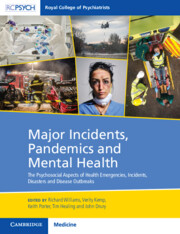 Major Incidents, Pandemics and Mental Health
Major Incidents, Pandemics and Mental Health Book contents
- Major Incidents, Pandemics and Mental Health
- Major Incidents, Pandemics and Mental Health
- Copyright page
- Dedication
- Contents
- Figures
- Tables
- Boxes
- Contributors
- Foreword by Dr Adrian James
- Foreword by Professor David Lockey
- Section 1 The Nature and Impacts of Twenty-First-Century Healthcare Emergencies
- Chapter 1 Emergencies, Incidents, Disasters, Disease Outbreaks, and Mental Health
- Chapter 2 How the World Views Trauma and Trauma Care
- Chapter 3 How the World Views the Mental Health Implications of Traumatic Events, Major Incidents, and Serious Contagious Diseases
- Chapter 4 Two Personal Perspectives on Trauma and Recovery
- Chapter 5 How Emergencies, Incidents, Disasters, and Disease Outbreaks Affect People and Healthcare Practitioners
- Chapter 6 The Impact of Emergencies, Terrorism, and Disease on Children and Their Families
- Chapter 7 The Impacts of Urbanising the World’s Population on Emergencies, Incidents, Disasters, and Disease Outbreaks
- Chapter 8 Myths About Disasters
- Chapter 9 Primary and Secondary Stressors
- Chapter 10 The Differing Challenges Posed by Big Bang, Rising Tide, and Longer-Term Incidents Affecting Local and Dispersed Populations
- Chapter 11 Mental Health in the Context of Multiple Exposures to Disasters
- Chapter 12 The Common Ground in the Mental Health Impacts of Emergencies, Incidents, Disasters, Disease Outbreaks, and Conflict, and a Framework for Responding to People’s Needs
- Section 2 Clinical Aspects of Traumatic Injuries, Epidemics, and Pandemics
- Section 3 The Role of the Public in Emergencies: Survivors, Bystanders, and Volunteers
- Section 4 Responses to Meet the Mental Health Needs of People Affected by Emergencies, Major Incidents, and Pandemics
- Section 5 Sustaining and Caring for Staff During Emergencies
- Section 6 Designing, Leading, and Managing Responses to Emergencies and Pandemics
- Section 7 Key Lessons for the Way Forward
- A Glossary of Selected Key Terms Used in This Book
- Index
- References
Chapter 12 - The Common Ground in the Mental Health Impacts of Emergencies, Incidents, Disasters, Disease Outbreaks, and Conflict, and a Framework for Responding to People’s Needs
from Section 1 - The Nature and Impacts of Twenty-First-Century Healthcare Emergencies
Published online by Cambridge University Press: 11 January 2024
- Major Incidents, Pandemics and Mental Health
- Major Incidents, Pandemics and Mental Health
- Copyright page
- Dedication
- Contents
- Figures
- Tables
- Boxes
- Contributors
- Foreword by Dr Adrian James
- Foreword by Professor David Lockey
- Section 1 The Nature and Impacts of Twenty-First-Century Healthcare Emergencies
- Chapter 1 Emergencies, Incidents, Disasters, Disease Outbreaks, and Mental Health
- Chapter 2 How the World Views Trauma and Trauma Care
- Chapter 3 How the World Views the Mental Health Implications of Traumatic Events, Major Incidents, and Serious Contagious Diseases
- Chapter 4 Two Personal Perspectives on Trauma and Recovery
- Chapter 5 How Emergencies, Incidents, Disasters, and Disease Outbreaks Affect People and Healthcare Practitioners
- Chapter 6 The Impact of Emergencies, Terrorism, and Disease on Children and Their Families
- Chapter 7 The Impacts of Urbanising the World’s Population on Emergencies, Incidents, Disasters, and Disease Outbreaks
- Chapter 8 Myths About Disasters
- Chapter 9 Primary and Secondary Stressors
- Chapter 10 The Differing Challenges Posed by Big Bang, Rising Tide, and Longer-Term Incidents Affecting Local and Dispersed Populations
- Chapter 11 Mental Health in the Context of Multiple Exposures to Disasters
- Chapter 12 The Common Ground in the Mental Health Impacts of Emergencies, Incidents, Disasters, Disease Outbreaks, and Conflict, and a Framework for Responding to People’s Needs
- Section 2 Clinical Aspects of Traumatic Injuries, Epidemics, and Pandemics
- Section 3 The Role of the Public in Emergencies: Survivors, Bystanders, and Volunteers
- Section 4 Responses to Meet the Mental Health Needs of People Affected by Emergencies, Major Incidents, and Pandemics
- Section 5 Sustaining and Caring for Staff During Emergencies
- Section 6 Designing, Leading, and Managing Responses to Emergencies and Pandemics
- Section 7 Key Lessons for the Way Forward
- A Glossary of Selected Key Terms Used in This Book
- Index
- References
Summary
This chapter introduces themes that recur throughout this book, and reflects on a collection of topics that are covered. One key theme concerns the common areas and differences in people’s responses and needs before, during, and after emergencies, incidents, disasters, and disease outbreaks (EIDD). It presents a strategic approach to meeting people’s mental health needs. Four areas common to EIDD are identified. First, preparedness before EIDD is critical to shaping how societies, communities, families, and people respond and recover. Second, a wide range of stressors have impacts on people affected by EIDD, and adversity and socioeconomic disadvantage play substantial parts in how people react, cope, and adapt. Third, the impacts of displacement are huge. Fourth, the wellbeing, psychosocial, and mental health agendas of care are extremely important aspects of the care that is required to meet the needs of survivors of EIDD and, often, those of their relatives.
Keywords
- Type
- Chapter
- Information
- Major Incidents, Pandemics and Mental HealthThe Psychosocial Aspects of Health Emergencies, Incidents, Disasters and Disease Outbreaks, pp. 63 - 78Publisher: Cambridge University PressPrint publication year: 2024
